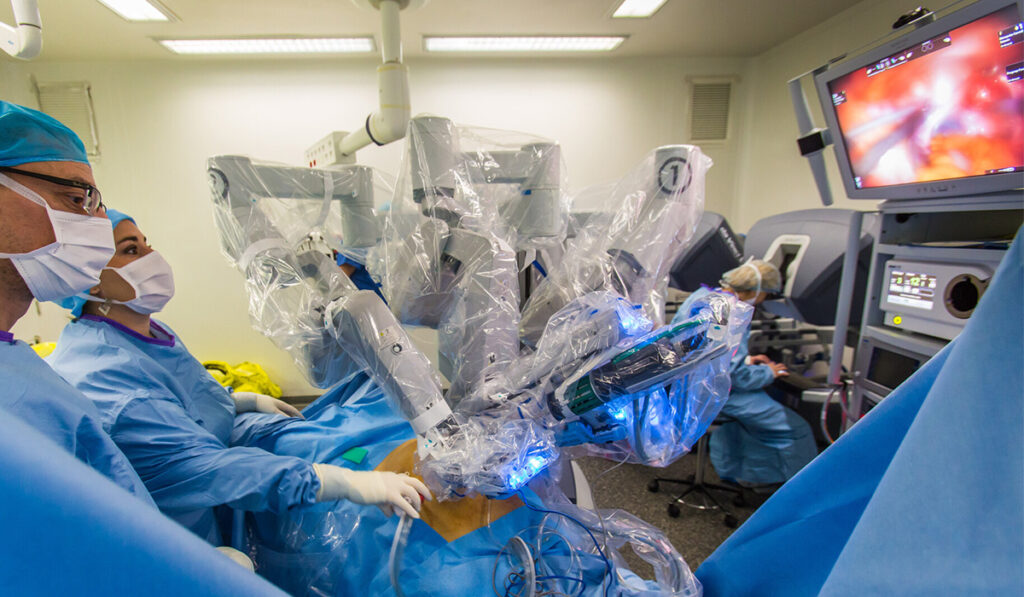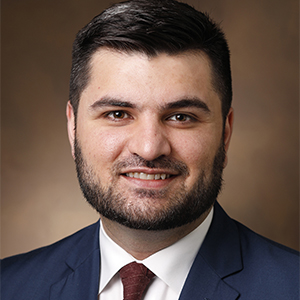Vanderbilt University Medical Center recently solidified its commitment to robotics surgical options by upgrading three da Vinci systems. This brings its total number of state-of-the-art model XI machines — shared among general surgery, thoracic surgery, obstetrics and gynecology, and urology — to five.
For GI surgery, robotics has the support of a new generation of residents steeped in its technology, as well as more seasoned converts. Aimal Khan, M.D., a colorectal surgeon at Vanderbilt, is a member of this new generation. Before joining Vanderbilt, he performed hundreds of robotic surgeries through residency and two fellowships.
“Before 2012, the adoption rate for various colorectal procedures was around three percent. Now it is around 16 to 26 percent,” he said. “I think future studies will show more patient benefit, as we get better and better at this technology. Plus, more surgeons will adopt it to avoid ergonomic injuries from doing laparoscopy (LAP) procedures.”
Michael Benjamin Hopkins, M.D., is the director for the colon and rectal surgery program at Vanderbilt. Ten years out from residency, he had to forge his own training path in robotics. “The investment Vanderbilt has made is significant – not just for the surgeries we are doing now – but for training the next generation of surgeons,” he said.
“The investment Vanderbilt has made is significant – not just for the surgeries we are doing now – but for training the next generation of surgeons.”
Equivocal Outcomes
Hopkins says the benefits of robotics over LAP are enticing: 3D visualization, a stable camera platform, image magnification, instruments immune from tremor, 360-degree motion, maneuverability in tight spaces and the ability to operate in all four quadrants in one procedure. Off-midline incisions can reduce hernia risks, he adds, and tissues can be taken out of the body for suture.
Yet Khan says research in GI surgery, primarily conducted in the early 2010s, shows LAP and robotics outcomes are a toss-up. He foresees this changing in the next decade and hopes to research the impact of robotic surgery on outcomes such as opioid use and length of stay. His anecdotal evidence is compelling, with many patients foregoing narcotics altogether and going home two days post-op.
Hopkins raises several questions that still require study. “Is there is a lower conversion rate to open surgery? Are there better oncological outcomes from robotics versus LAP?”
Robotic surgery detractors cite the lack of haptic feedback and the higher cost and may balk at the significant learning curve required for transition, Hopkins says. “Some doctors reserve robotics for rectal cancer; others see benefits from broader use. You have to do the procedure you are most comfortable with and best at.”
Weighing Costs Against Surgeon Health
In 2014, one analysis found a robotic colectomy cost $3,424 more than LAP, a margin Khan says is narrowing. “There is a clear trajectory where the costs are decreasing as new manufacturers are producing competitive machines,” he said.
An important reason robotics is catching fire is a rising awareness of the physical toll LAP procedures can take on surgeons. While 68 percent of surgeons overall report physical discomfort during surgery, minimally invasive surgeons are most likely to report pain, fatigue and numbness.
“We have this whole generation of surgeons developing back and neck problems from manipulating these long, straight sticks over two or three procedures in a day,” Khan said. “Robotic systems are expensive, but how do you weigh that against the benefit of keeping a surgeon working ten years longer?”
“Robotic systems are expensive, but how do you weigh that against the benefit of keeping a surgeon working ten years longer?”
Robotics Back in Center Field
The robotics work at Vanderbilt is rapidly building on its track record. Hopkins was on the team that performed the first robotic abdominal perineal resection last year. Khan recently performed the first robotics-assisted total colectomy at Vanderbilt.
“Before, when GI surgeons who trained in open and LAP surgeries added robotics to their armamentarium, it was mostly for pelvic and rectal surgeries, where tight spaces precluded LAP stick entry,” Hopkins said. “It’s been a big shift to see it used today to resect right colons, do total colectomies, or work on other parts of the abdomen.”






